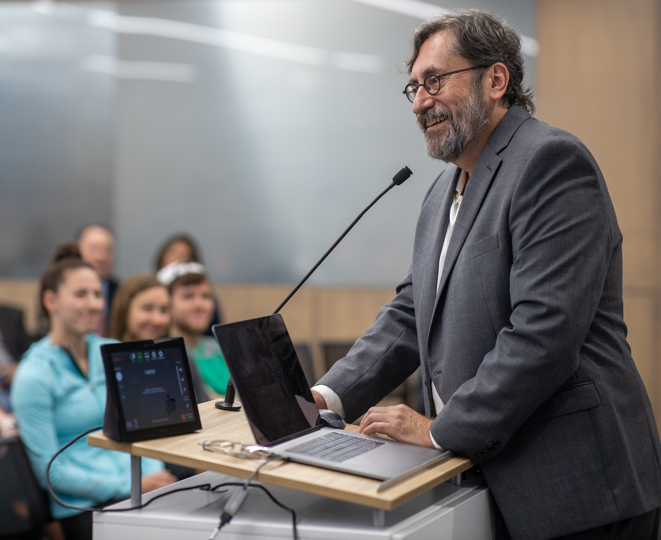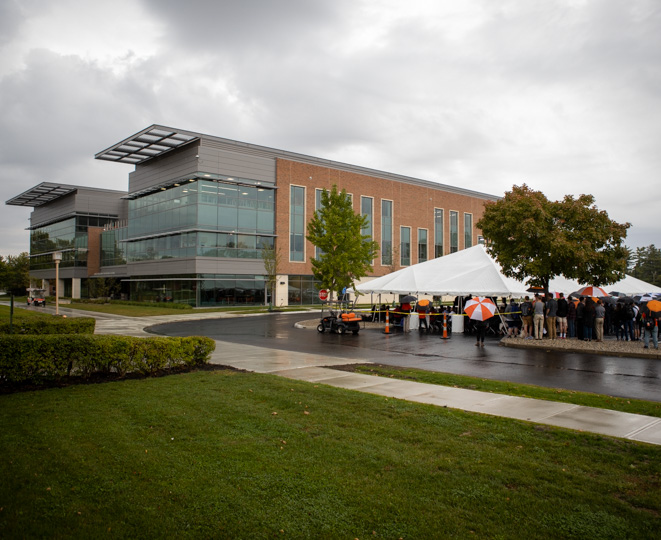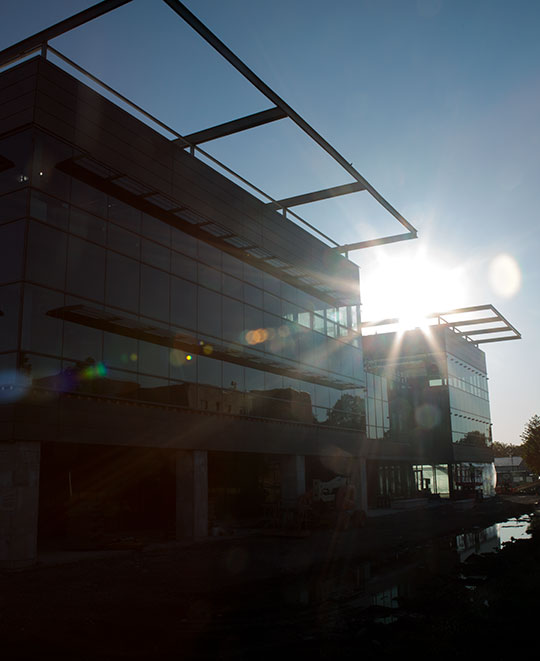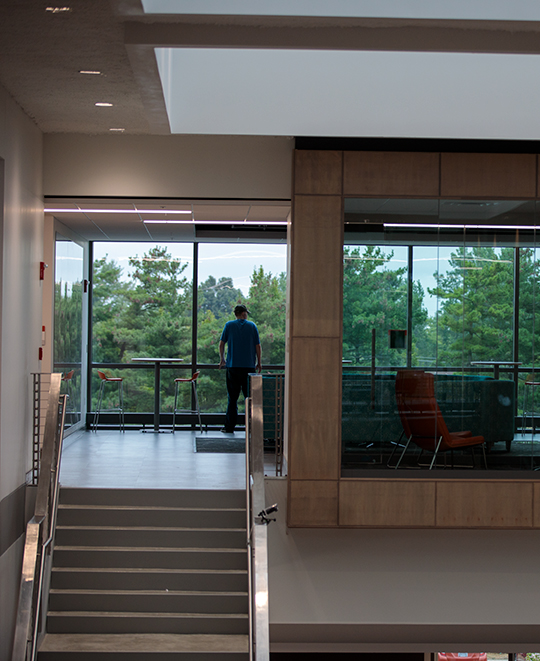Building dedication events
Ohio Northern University celebrated the opening of the James Lehr Kennedy Engineering Building on Thursday, Oct. 10 and Friday, Oct. 11. Events included a dedication ceremony, Campaign for Engineering closing event, and a presentation from award-winning director and screenwriter for Pixar Animation Studios, Bob Peterson, BSME '83.

The Campaign by the numbers
The new building is twice as large as the current one and offers more space for collaboration, class projects and community-building.
-
$16.9 million dollars were given by alumni and friends
-
770 donors contributed to the campaign
-
10% of the donors were first-time donors
-
$13 million additional dollars were raised to support other engineering-related projects
-
By all accounts, the new James Lehr Kennedy Engineering Building will have a transformative effect on the T.J. Smull College of Engineering at Ohio Northern University. Opening in fall 2019, the 105,000-square-foot facility will be nearly twice the size of the Biggs Engineering Building and will feature space for collaboration, class projects and community-building, helping ONU remain on the cutting edge of engineering education.
But beyond what the building will allow students to do, there is one feature within the building that will remain a testament to what one group of students has done. Senior electrical engineering students Dan Musci and Jacob Hull, along with senior computer engineering student Jack Roudebush, worked together on a capstone project with extra significance to the new home of ONU engineering and its namesake James Lehr Kennedy.
Kennedy, the great-grandson of ONU founder Henry Solomon Lehr, is a lead benefactor of the “Campaign for Engineering: Building Impact at ONU." He is also an artist, and in addition to his financial contribution, he donated The Tower of Inspiration, a nearly 20-foot-tall glass art installation, to adorn the building’s atrium. But before it could be installed, Kennedy entrusted Musci, Hull and Roudebush with a formidable task: to complete his original vision.
Kennedy created the sculpture nearly a decade ago for the lobby of his former company Twenty First Century Communications (TFCC). The concept was actually influenced by Superman’s Fortress of Solitude, with hand-blown hexagonal glass crystals in place of Arctic ice.
Fully assembled, The Tower of Inspiration consists of 380 glass crystals, each weighing between 15 and 22 pounds, arranged on rings mounted to a structural steel frame. At TFCC, the entire piece was lit with colored floodlights to reflect light and energy upon visitors. But that was not Kennedy’s original intent.
“What I really wanted to do was have each crystal lit individually from within, but we ran out of two important things: time and expertise,” he says.
In the capstone team, Kennedy found both. In electrical engineers Musci and Hull and computer engineer Roudebush, the team has the know-how to make Kennedy’s initial plan a reality. They spent a combined 24 to 30 hours a week on the project to not only complete the task, but also take this new iteration of The Tower of Inspiration to previously undreamed of heights.
Dr. Kennedy always wanted it to be internally lit, so we set out to do that from the start using LEDs mounted to rings that fit the diameter of the base of each crystal. Since we are using addressable LEDs that actually interpret data, we can program them to do things like change color or intensity, or even sync them to music,” says Musci.
It’s a quantum leap from floodlights, but with the virtually unlimited potential of addressable LEDs comes an increasing level of complexity, made even more so by the inherent intricacy of the sculpture itself.
For instance, each 2-foot long crystal is actually suspended from a rod that is bolted to the frame and travels the length of the entire crystal so that the contact point is at the thickest (and strongest) glass. Fortunately for the team, Kennedy designed the rods with a threaded cap at the end to allow for fine-tuning. Had he not, there wouldn’t have been a way to accommodate for the thickness of the LED ring at the base. As smart as these devices are, they aren’t made to withstand 22 pounds of pressure, so by adjusting the cap the team could make sure the steel rod still held all of the crystal’s weight.
Wiring the LEDs, along with a microprocessor and all the required circuitry, was also a challenge made more difficult by the sculpture’s stature.
“The biggest issue we have run into is the delay from the software to the LEDs,” says Hull. “We are working to get that down to as little time as possible, because if you change nearly 400 lights and there is a half-second delay between the bottom and the top, you are obviously going to be able to see that. We need to get that down to microseconds so the human eye can’t detect it.”
The good news is that once the delay issues are solved, they will be solved for good. Think of it as a calibration of sorts. This means that the real fun can begin in designing lighting patterns and schemes. In fact, once the hardware is finished, software changes are easy. According to Roudebush, the team even hopes that the tower can be used in the future as a teaching tool, a giant, three-dimensional display board for computer science students to write their own programs that control the lights.
Kennedy says that his sculpture “symbolizes the moment when an idea crystalizes in one’s mind and becomes a reality.”
Now, at long last, his idea – in its entirety – will be.

'Building Inspiration' - Crystal Tower Installation at Ohio Northern University
A video highlighting the construction of the 'Inspiration' crystal tower in the James Lehr Kennedy Engineering Building at Ohio Northern University. This video is courtesy of ThreadPath Media.
The ultimate learning environment
The brand-new James Lehr Kennedy Engineering Building was designed to enhance the hands-on learning and faculty-student interaction that sets ONU apart. Students asked for more space to work and for more natural light, and we delivered with 105,000 square feet of glass-wrapped collaboration spaces, huddle rooms and labs for teams to work. At its center, a large glass sculpture created by our naming benefactor, James Lehr Kennedy, is lit internally with hundreds of programmable LEDs in a system designed by our students.
Campaign Testimonials
The Campaign for Engineering is a major step forward for engineering education at Ohio Northern University. Click on the names below to read why the Campaign chairs feel so strongly about making such an investment in ONU engineering.
-
"ONU Engineering is unique. That's what drew me to Northern in the first place - the uniqueness of a top-notch engineering program that encourages personal growth outside of the engineering core, set in a small-school environment. This model needs to be guarded and nurtured for the next generation of students. It's a model that fostered my growth, having the soft skills of cartooning and art combining with the hard science of engineering - leading to a career in computer graphics. I will always be grateful to ONU."
-
"Over the years, ONU has never stopped evolving - but the foundation of our education has never changed: our focus on people and the communities they impact. This campaign has allowed us to continue to evolve and grow while preserving everything our students and alumni cherish about the education we provide."
-
"The educational experience that Ohio Northern provides for its students has a significant impact on their paths to successful lives. It is rare to find an opportunity to make a real difference in something this important, and that's why I committed to the successful completion of the Campaign for Engineering: Building Impact at ONU."















